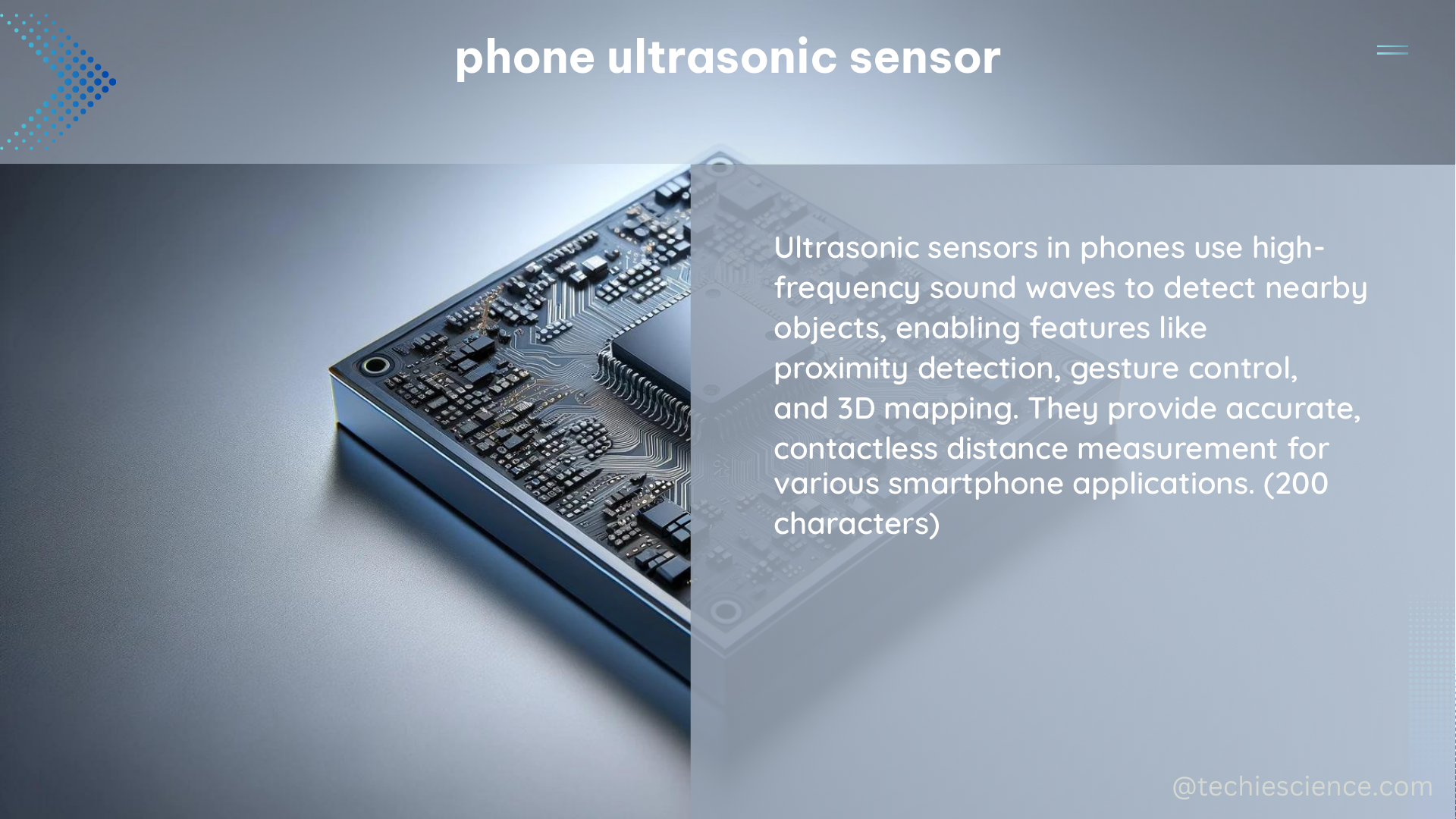The phone ultrasonic sensor is a cutting-edge technology that utilizes high-frequency sound waves to detect and measure distances with remarkable precision. This versatile sensor finds applications in a wide range of domains, from motion detection and object recognition to distance measurement and environmental monitoring. In this comprehensive guide, we’ll delve into the technical specifications, performance characteristics, and real-world applications of phone ultrasonic sensors, equipping you with the knowledge to harness their full potential.
Understanding the Fundamentals of Phone Ultrasonic Sensors
At the core of phone ultrasonic sensors is the ability to emit and detect high-frequency sound waves, typically ranging from 20 kHz to 200 kHz. These sound waves, which are beyond the audible range of human hearing, are used to measure the distance to nearby objects by calculating the time it takes for the sound waves to travel and reflect back to the sensor.
The key technical specifications of phone ultrasonic sensors include:
-
Frequency Range: The operating frequency range of phone ultrasonic sensors typically falls between 20 kHz and 200 kHz, with the specific range depending on the sensor model and application requirements.
-
Measurement Range: The distance that phone ultrasonic sensors can accurately measure varies, with some models capable of detecting objects up to several meters away. For instance, the UMP3 ultrasonic hydrostatic leveler has a measurement range of 40 mm.
-
Accuracy and Precision: The accuracy and precision of phone ultrasonic sensors are crucial factors, as they determine the reliability and reliability of the distance measurements. The UMP3 leveler, for example, boasts a resolution of 0.1 μm (0.0001 mm), showcasing its exceptional precision.
-
Long-Term Stability: The long-term stability of phone ultrasonic sensors is another important consideration, as it reflects their ability to maintain consistent performance over time. The UMP3 leveler demonstrates a long-term stability of 5.0 μm (0.005 mm) over one year, ensuring reliable and accurate measurements.
-
Environmental Operability: Phone ultrasonic sensors must be able to function reliably in various environmental conditions, such as temperature and humidity. The UMP3 leveler, for instance, can operate in temperatures ranging from -20 °C to 50 °C, making it suitable for a wide range of applications and settings.
Exploring the Applications of Phone Ultrasonic Sensors

The versatility of phone ultrasonic sensors allows them to be employed in a diverse array of applications, each leveraging their unique capabilities:
Motion Detection
Phone ultrasonic sensors are widely used for motion detection, as they can accurately track the movement of objects and people. This technology is commonly found in devices like Amazon’s Echo, where the ultrasonic sensor has a frequency range of 32 kHz to 48 kHz and a detection latency of 50 milliseconds.
Distance Measurement
Precise distance measurement is a key application of phone ultrasonic sensors. The UMP3 ultrasonic hydrostatic leveler, for instance, is used to measure various construction shifts and tilts with a resolution of 0.1 μm (0.0001 mm).
Object Detection
Phone ultrasonic sensors can be used to detect the presence and location of objects, enabling applications such as automated parking systems, robotic navigation, and industrial automation.
Environmental Monitoring
Ultrasonic sensors can be employed in environmental monitoring applications, such as measuring water levels, detecting leaks, and monitoring soil moisture content.
Medical Applications
In the medical field, phone ultrasonic sensors find use in applications like non-invasive blood pressure monitoring, respiratory rate tracking, and even in-utero fetal monitoring.
Optimizing Phone Ultrasonic Sensor Performance
To ensure optimal performance and reliability, it’s essential to consider the following factors when working with phone ultrasonic sensors:
-
Sensor Placement: The positioning of the ultrasonic sensor is crucial, as it can affect the accuracy and range of the measurements. Factors such as the sensor’s orientation, proximity to obstacles, and environmental conditions must be carefully considered.
-
Signal Processing: Effective signal processing techniques, such as filtering and noise reduction, can enhance the sensor’s ability to accurately detect and measure distances, even in challenging environments.
-
Calibration and Maintenance: Regular calibration and maintenance of phone ultrasonic sensors are necessary to maintain their accuracy and precision over time. This may involve adjusting sensor parameters, cleaning the sensor surface, and verifying the sensor’s performance against known references.
-
Integration with Other Technologies: Combining phone ultrasonic sensors with complementary technologies, such as machine learning algorithms or data fusion techniques, can further improve the sensor’s capabilities and unlock new application possibilities.
Conclusion
Phone ultrasonic sensors are a remarkable technological advancement that harnesses the power of high-frequency sound waves to enable a wide range of applications, from motion detection and distance measurement to object recognition and environmental monitoring. By understanding the technical specifications, performance characteristics, and optimization strategies, you can unlock the full potential of these sensors and integrate them into your projects and solutions, driving innovation and enhancing the capabilities of your devices.
References
- The science behind ultrasonic motion sensing for Echo. (2021, March 4). Amazon Science. https://www.amazon.science/blog/the-science-behind-ultrasonic-motion-sensing-for-echo
- Sensor tutorial 5: Ultrasonic Sensors (5 of 7) – YouTube. (2017, October 26). YouTube. https://www.youtube.com/watch?v=7wS2FXffjfI
- Ultrasonic Sensors Enabling Early Detection of Emergency Trends. (2021, March 4). National Center for Biotechnology Information. https://www.ncbi.nlm.nih.gov/pmc/articles/PMC7961917/

The lambdageeks.com Core SME Team is a group of experienced subject matter experts from diverse scientific and technical fields including Physics, Chemistry, Technology,Electronics & Electrical Engineering, Automotive, Mechanical Engineering. Our team collaborates to create high-quality, well-researched articles on a wide range of science and technology topics for the lambdageeks.com website.
All Our Senior SME are having more than 7 Years of experience in the respective fields . They are either Working Industry Professionals or assocaited With different Universities. Refer Our Authors Page to get to know About our Core SMEs.